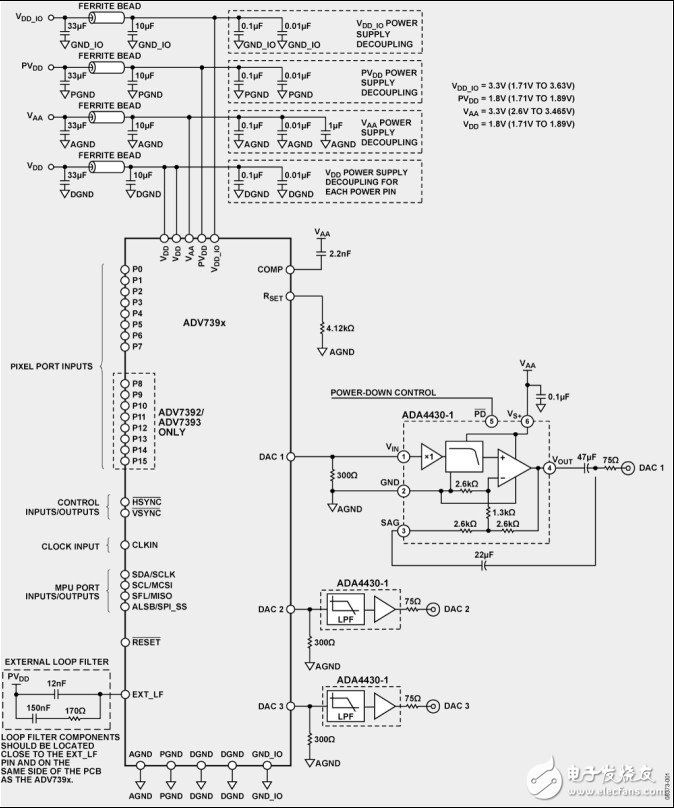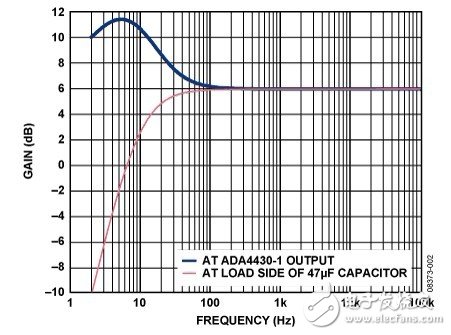Circuit function and advantage
This circuit consists of a digital-to-analog video converter combined with a low-cost, low-power, fully integrated reconstructed video filter. While many video encoders (video DACs), such as the ADV7393, can directly drive video loads, it is often advantageous to use video drivers at the output of the video encoder to save power, implement line drivers, and provide better circuit protection. The video driver is typically configured as an active filter, also known as a reconstruction filter or an anti-mirror filter. The reconstruction filter has two functions: to block the higher frequency portion of the video signal (higher than the Nyquist frequency) during the digitization process, and to provide gain to drive the 75 Ω external cable connected to the video display. For AC-coupled output applications, the ADA4430-1 integrates a signal amplitude gain (SAG) correction network. The 150 Ω load resistor and output coupling capacitor of the rear termination cable form a high-pass filter that provides low-frequency compensation for the high-pass filter using SAG correction. SAG correction can reduce the traditional large AC coupling capacitor (330 μF) requirements with a smaller 47 μF and 22 μF capacitor instead.
Both the ADA4430-1 and ADV7393 are recommended for use in the automotive sector and are ideal for infotainment systems and vision-based security systems. 
Figure 1: Low-cost, fully integrated reconstruction filter using the ADA4430-1 (schematic diagram)
Circuit description
The ADV7393 is a low-power, fully integrated digital video encoder that converts 16-bit digital component video data, such as CMOS back-view cameras, into standard analog baseband video signals that are compatible with global standards. Three 2.6 V/3.46 V 10-bit video DACs support composite (CVBS), S-Video (YC) or component (YPrPb/RGB) analog outputs in standard definition (SD) or high definition (HD) video formats. The circuit shown in Figure 1 is configured for a low output drive mode that reduces the output current of all three DACs by 85% (RSET = 4.12 kΩ, RL = 300 Ω). To further save power, the internal PLL can be disabled and the encoder can be operated in 2&TImes; oversampling mode. The 16-bit video input port is configured to support standard definition video.
The ADA4430-1 is a single-channel, sixth-order, low-pass video filter with a −3 dB cutoff frequency of 9 MHz and an out-of-band rejection of 50 dB at 27 MHz. The device is a low power, low cost, rail-to-rail output amplifier that operates from a +2.5 V to +6 V supply and is ideal for SD video applications. When used with the ADV7393 single-chip video encoder, the ADA4430-1 provides the most efficient video output solution for automotive applications. In Figure 1, the ADA4430-1 is configured to reconstruct a video filter that provides AC-coupled output and SAG correction. The compensation network includes the internal resistor network integrated in C1, C2 and ADA4430-1. Traditional AC coupling uses expensive, large coupling capacitors that are costly and waste valuable PCB space. SAG correction can replace a large AC coupling capacitor with two smaller, low cost capacitors while maintaining the same field tilt. Field tilt is a measure of the voltage drop (tilt) produced when a constant luminance signal is applied to an ac coupling capacitor. This voltage drop is caused by a small discharge current generated by a 75 Ω load resistor. Selecting the appropriate SAG correction capacitor value results in a field slope comparable to a 220 μF ac coupling capacitor.
When using the SAG correction circuit, the gain from the input of the ADA4430-1 to the nearest output is 2.5 (≈8 dB) at very low frequencies. In this case, the external feedback loop consisting of a 22 μF capacitor is effectively turned on (see Figure 2) and exhibits a second-order peak of approximately 11 dB at approximately 5 Hz. This gain is approximately 7.5 dB at 30 Hz. When considering low frequency input and output signal swings, this extra gain must be noted to keep these swings within the specified limits. The gain from the ADA4430-1 input to the 47 μF capacitive load does not exhibit this behavior; rather, it is more like a unipolar high-pass response.
Figure 2 shows the SAG frequency response in the immediate vicinity of the ADA4430-1 output and the 47 μF capacitive load.

Figure 2: SAG Corrected Frequency Response at the ADA4430-1 Output and 47 μF Capacitor Load
Buffering is very important, but it is often overlooked. For example, many automotive application customers use low-cost amplifiers to protect expensive and complex devices such as video decoders and encoders. An amplifier with an AC-coupled output, as shown in Figure 1, helps protect these devices from overvoltage and ESD damage.
Common changes
There are several options for AC-coupled output configurations. The SAG correction shown in Figure 1 uses 22 μF and 47 μF capacitors. The traditional AC-coupled output uses a 220 μF capacitor; in this configuration, the SAG pin is directly connected to the output pin before the output capacitor. For DC-coupled configurations, the SAG pin is also tied directly to the output pin. In a DC-coupled configuration and a traditional AC-coupled configuration, connecting the SAG pin directly to the output pin produces a +2 gain buffer at all video frequencies.
Water-cooled capacitor is supercapacitor is a capacitor with a capacity of thousands of farads.According to the principle of capacitor, capacitance depends on the distance between the electrode and electrode surface area, in order to get such a large capacitance, as far as possible to narrow the distance between the super capacitor electrode, electrode surface area increased, therefore, through the theory of electric double layer and porous activated carbon electrode.
Water-Cooled Capacitor,Water-Cooled Power Capacitor,Water-Cooled Electric Heat Capacitor,Water-Cooled Electric Heating Capacitor
YANGZHOU POSITIONING TECH CO., LTD , https://www.yzpstcc.com